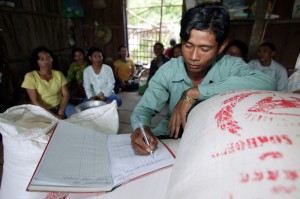Stuck in the bottom of your stocking
A smarter business model for USAID
Most people probably weren’t paying attention to the Washington Post business page on Dec 25. (Myself, I was trying to corral two toddlers and navigate a sea of legos and torn paper). But for people in poor countries who are trying to lead their societies out of poverty, Christmas day brought good news: USAID is changing the way it works to get closer to the people it’s trying to help.
Since Administrator Rajiv Shah came on board, USAID has been trying to rebuild itself so it can build stronger partnerships with poor countries and their people. It’s based in the reality of good development, which is that development isn’t something done by USAID—development is done by poor people and poor countries themselves. In order to be a better partner, USAID needs to get closer to poor people to know better what they actually need and want. That means having more USAID people talking and working directly with people in poor countries.

This isn’t a new idea; it’s called “partnership,” and the hard-working people at USAID have been trying to do it since the agency was created 50 years ago—with varying degrees of success. The problem is that budget cuts in the 90’s gutted the agency’s ability to do this well. Budget cutters defined “efficiency” as more dollars managed by fewer people, rather than judging the depth and effectiveness of USAID’s partnerships. As a result, things deteriorated to the point where USAID contracting officers were each managing five times the amount of money that federal guidelines said they should. By necessity, USAID’s business model was reduced to “shoveling money out the door” rather than getting to know countries, communities, leaders, and their needs.
Increasingly, to manage this, USAID starting relying on “intermediaries”; often well-meaning partners like big NGOs and contractors that could manage the money for them. US-based NGOs and contractors each have distinct roles and contributions to make to development. But in this case, the way they were used was both a substitute for USAID expanding its own knowledge and expertise, as well as an impediment to change leaders in poor countries being able to tell the US government what they really needed.
Administrator Shah is trying to change that. The Dec 25 Washington Post article unveiled his effort to get USAID back to a better business model, by cutting out the middlemen and putting more emphasis on building relationships directly with the people who are making development happen in their own countries. These are exactly the kind of people that the United States wants on our side: not because of charity or because they necessarily like us, but because they want the same things we do: a world that can fight back against problems like poverty, injustice, and disease.
These reforms have a rather bureaucratic sounding name: “Implementation and Procurement Reform.” But what they mean in practice is that USAID is making an effort to get back on the ground to work more closely with the people it’s trying to help. That means better value for American taxpayers, more power for change leaders in poor countries, and ultimately better progress in the fight against poverty.